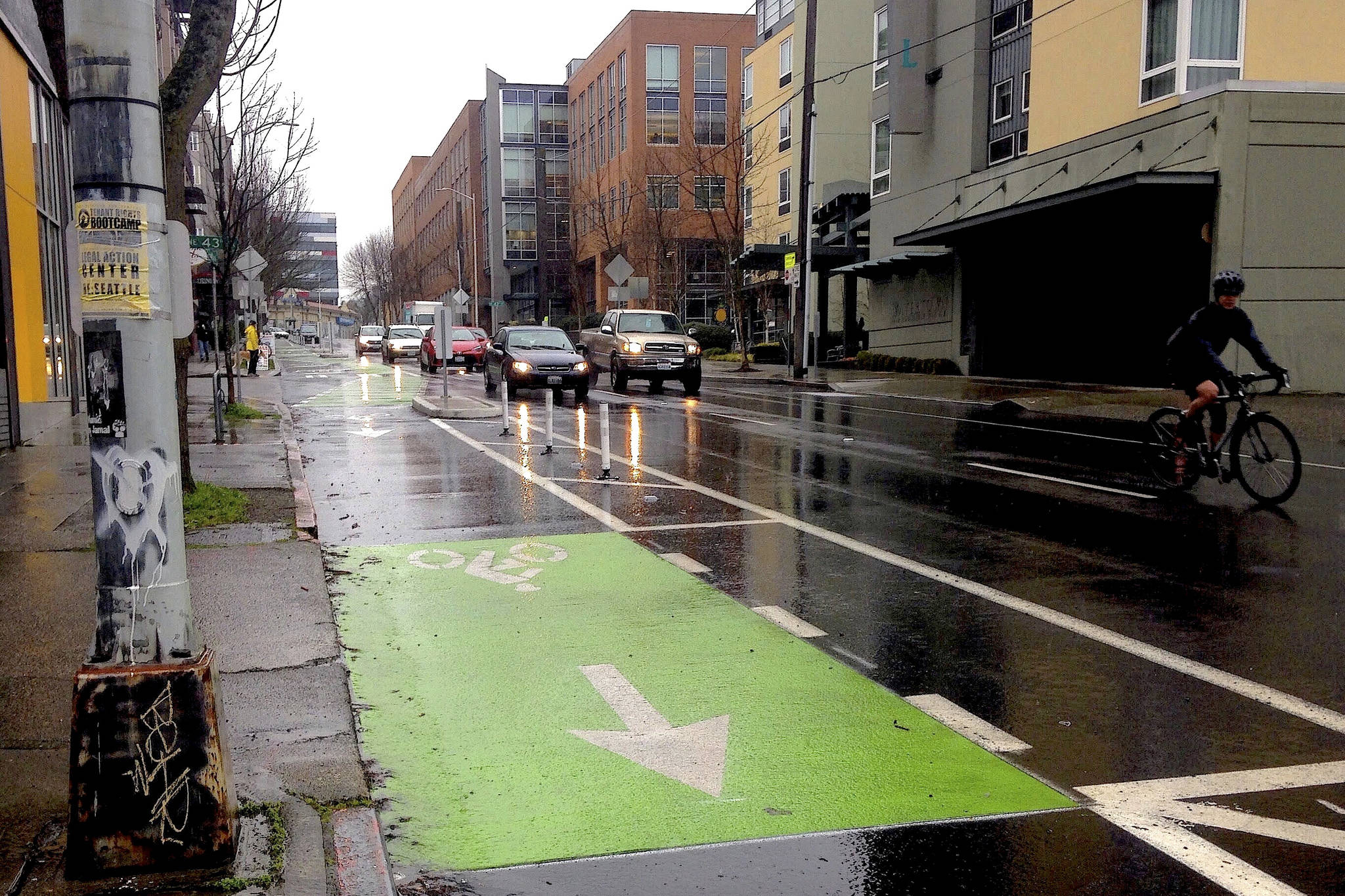This story was produced in conjunction with the University of Washington’s News Lab.
Seattle’s bicycle community is a large reason why the city is one of the greenest in the nation, but the city’s recent implementation of protected bike lanes is making some enemies.
While improving safety, the process of adding these lanes has also taken over already rare parking spots. This longrunning Seattle debate has now reached Roosevelt Way NE, where a protected bike lane was unveiled in November.
One store owner in North Seattle, for example, is moving his mattress business to Lake City after the protected bike lane took away his storefront parking spaces.
“We had 30-minute parking out front and that was what our customers use, especially for loading on and off,” Dean Hackbarth, owner of Friendly Foam on Roosevelt Way NE, says. “Some of the things we deal with are king-size beds and other bulky stuff and we would use big semi-trucks to unload those early in the morning. Basically, our ability to unload the trucks just about stopped.”
After Hackbarth attended several city and neighborhood council meetings, transportation officials decided to move forward with the bike lanes. Now, when trucks unload cargo, they must pull into a driveway, rather than use street parking. Then, when they leave, they must reverse onto the heavily trafficked Roosevelt Way. This process has the trucks cross over the newly installed bike lane, twice.
“It’s just not effective, and really quite dangerous,” Hackbarth says. “We were all for the bike lanes, we like that kind of transportation, but if they would have put it one road over east or west, it would have been safer for the bikes and the small businesses would have maintained their parking.”
The bike lanes eliminated over 120 parking spaces on Roosevelt, and Hackbarth said that along with making deliveries difficult, the decreased parking is driving away customers.
“We’ve had 13 people in a day call us and say that they couldn’t find a place to park within three blocks,” Hackbarth says. “So they didn’t end up coming. And in that day, we started looking and saw three, maybe four bikes all day long. So, we lost 13 customers to three or four bikes.”
But not everyone is taking such a dim view of the bike lanes. Fletcher Moore is a student at the University of Washington who uses the new lanes often.
“It’s a pretty ideal situation, especially when you consider how long and straight the road is,” he says.
Chet Merklin, manager of the bike shop at UW, says that in a perfect world, there would be enough room in a city for parking and bike lanes. But as is, hard choices must be made, and bike lanes make sense for a city that wants to encourage alternative forms of transportation. While he says he’d “hate to see” small businesses pushed out by parking issues, he thinks the city should stay the course.
“I think that the direction that the city is headed is perfect,” Merklin says. “I just want to see that maintained.”
“With the influx of people into the city, [alternative transportation] gets even more important,” he adds.
In more populous areas, a five-year master plan for 2016-2020 outlines the future of bike lanes in Seattle. Downtown on Second Avenue, between Pike Street and Denny Way, a 1-mile protected bike lane is set to be completed by the end of this year to help expedite the commute for the 1,000-plus bikers that use the route each day. The city hopes the addition of the lanes there will decrease the intermixing of bike traffic with cars.
At the heavily visited downtown area, the fight for space is even more intense.
“The city is growing and we can’t increase the size of the roads,” says Dawn Schellenberg, a community engagement liaison at the Seattle Department of Transportation. “We want the transit areas to be safe for all. Everyone should have the most efficient options to travel while keeping the expansion of our city possible.”
To increase safety on the street, where 60 collisions involving bikes have occurred in the last four years, the bike lanes have two lanes for cyclists while also incorporating a signalized left turn for cars (half of those accidents involved a left turn).
Projects like this, however, are costly.
With the Move Seattle levy approved by voters in 2015, the city plans to build at least 40 more miles of protected bike lanes and 50 more miles of neighborhood greenways, at an estimated cost of $85 million. SDOT reports that 86 percent of the funds will come from property taxes, with the remainder from grants.
All the money that’s going into the bike lanes is appearing to make a noticeable difference, the bike plans have showed. Bike ridership tripled on Second Avenue after the bike lanes were installed in 2014. The goal for all added lanes, in terms of safety, is to cut the bicycle collision rate in half by 2030. From 2013 to 2015, such incidents decreased by 4 percent.
Still, in a dense city like Seattle, bike lanes come at a cost to other amenities, like parking. People like Hackbarth aren’t convinced it’s a tradeoff worth making, and worries the dream of making Seattle a bike city is clouding reality.
“Just look at the bike share system,” Hackbarth says, referring to the Pronto program the city earlier this announced it was shutting down. “They pumped millions of dollars into that and it was a fail… I’m a biker and I want Seattle to be a bike town, but there are a lot of factors that make that tough to be that here.”




